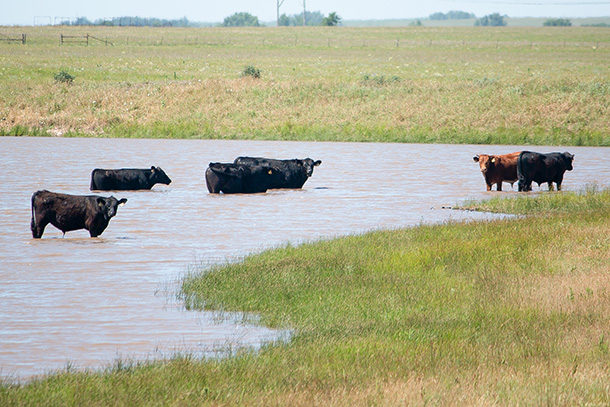Not only did it heat up during the day, says AJ Tarpoff, associate professor and beef extension veterinarian specialist at Kansas State University, but the heat did not let up during the night, giving cattle no break from heat and the stress it puts on their bodies.
Estimated numbers lost range in the thousands, and while there will not be an exact number, any number lost from heat is too many. Because weather is unpredictable, the best defense against heat is to be prepared and have a plan in place for when it starts to heat up, says Nick Simmons, University of Florida Institute of Food and Agricultural Sciences Extension Service.
“Heat stress is just like any other environmental stressor on animals,” Tarpoff says. “However, it's not just temperature. It’s temperature, humidity, wind speed and solar radiation.”
Those four factors are encompassed in the Cattle Comfort Index (CCI), which gives a value for what it really feels like for cattle. As it gets warmer, the internal temperature of cattle elevates, and they must dissipate it, or sweat, to be able to cool down naturally, but cattle inherently have a very ineffective sweating capability, Tarpoff says.
Instead, they may dissipate that heat by taking advantage of wind currents to help expel it from their bodies. They also use their respiratory tracts to release heat through breathing. Like a dog panting, cattle can essentially do the same thing to help cool themselves through the moisture in their mouths.
“Temperatures between the upper 30s to 70s Fahrenheit is the thermal neutral zone where cattle can be found in their normal state,” Simmons says. “Above [that], especially with humidity, is when cattle start to become uncomfortable. Anything into the 80s would be where we see more energy expenditure to cool down.”
However, air temperature isn’t always the best indicator for what an animal actually feels, Tarpoff says. Agencies like Kansas Mesonet have started to develop and use specific models that incorporate temperature, humidity, wind speed and solar radiation into a “feels like” temperature.
“But more importantly, it's not necessarily a one-time spike or a one-time-daily heat load,” Tarpoff says. “It's multiple days. What's critical with heat stress is nighttime cooling. Animals are amazing in their ability to accumulate heat during the day and can be just fine as long as they have about six hours of nighttime cooling, where they're able to dissipate the heat from the day. Then they can start the next day at what we consider thermal neutral. If they're not able to do that, or if we have multiple days [where] we don't get enough nighttime cooling, those are the situations that can be pretty dangerous.”
When evaluating your cattle for heat stress, here are a few signs to look for:
- Any behavioral changes
- Labored and/or open-mouth breathing
- Cattle laying down a lot and not grazing
- Salivating or drooling more than normal
- Cattle grouping around water sources
- For cattle in confinement: not wanting to lay down because the ground is hot
Animals that deal with heat stress can be affected in the long term. Whether it is a nursing calf or a steer in the feedlot, cattle won’t be gaining weight on those days when dealing with heat stress and will be behind in weight gain and growth, Simmons says.
“During the times of heat stress, there are some physiologic changes that come at a cost,” Tarpoff says. “Because they are spending the day trying to cool themselves, cattles’ maintenance energy costs go up. And unfortunately, at the same time, their daily intake of feed goes down. So essentially, what's happening is that the excess energy spent to cool themselves has a negative effect on overall performance.”
Additionally, there can be lingering effects of heat stress on reproduction, either loss of early embryo, loss of early pregnancy or even decreased fertility of bulls.
“The bull has to regulate the temperature of the teste,” Tarpoff says. “And if that doesn't happen, [he] can experience a heat shock to the testicles and may have decreased fertility for upwards to 60 days.”
Here are a few tips for producers when preparing for heat:
- Make sure to have plenty and easy access to good, clean water.
- If possible, increasing the number of water tanks or the capacity of tanks.
- Provide shade structures.
- If cattle have access to a barn or shed, use fans and misters.
- Don’t work, move or ship cattle. If you have to, do it in the early morning or late night when it is cooler.
- Add bedding to keep floors cool.
- Modify or limit rations to decrease internal heat produced by fermentation.
“It all comes to prior planning,” Simmons says. “Have a plan in place on what strategies can you implement on your operation. And have that plan written out and communicated within your team before an event happens.”












